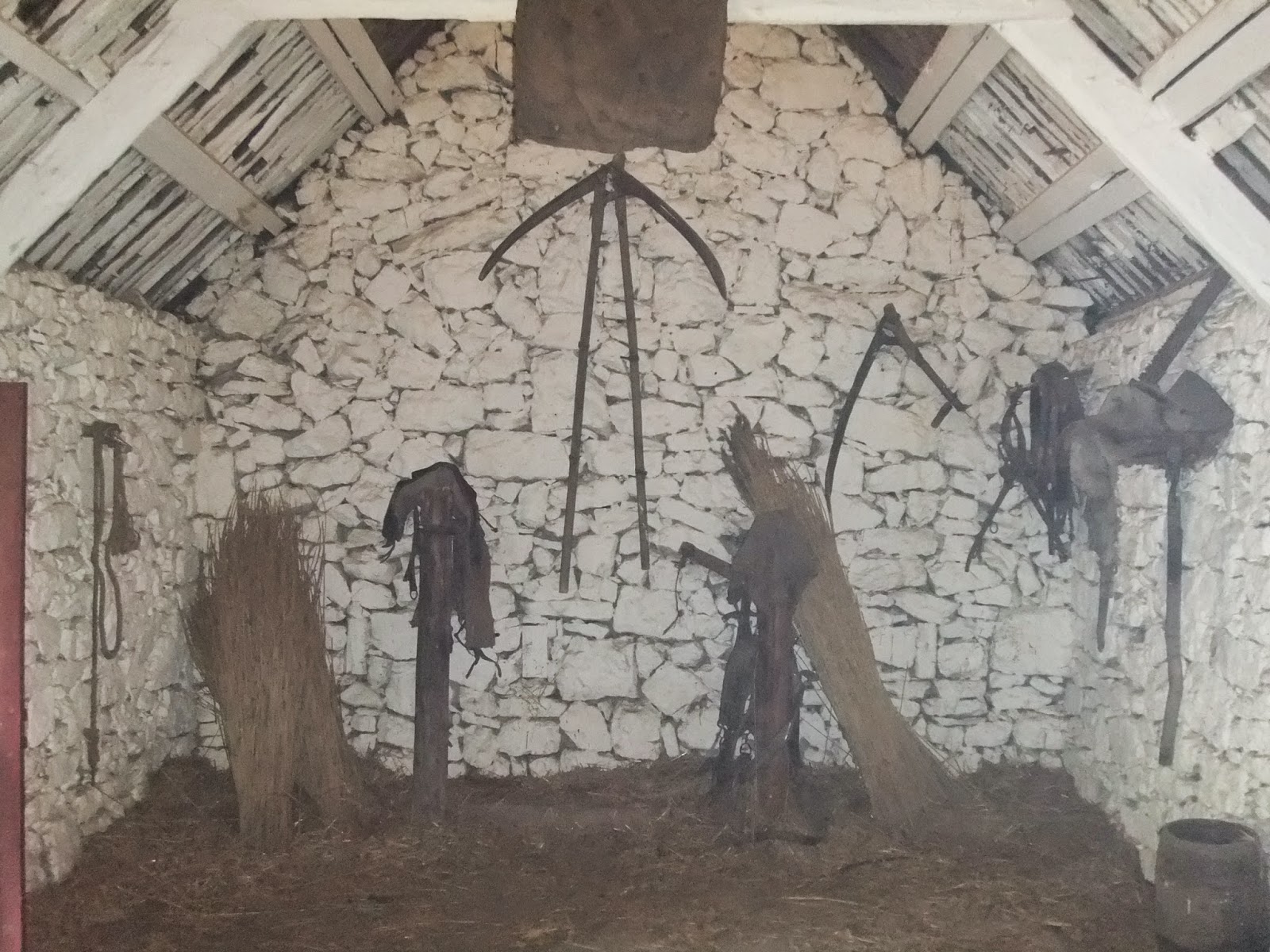Last was Bunratty Castle, dating from 1425, the last of a series of castles on the same site. Only saw a couple of castle rooms, as claustrophobia overtook me on those narrow, steep and winding stairs inside. Didn't see the many other rooms nor the four towers. But I got the gist of it. Very different from castles I'd seen in England and Germany.
(Click photos to enlarge.)
Byre Dwelling
An example from County Mayo of a dwelling occupied by both the family and their milking cows. Pigsty nearby.
Walking down the road, I skipped going into a working corn mill and an undershot watermill.
Ardcroney Church
This church was moved stone by stone from Ardcroney in County Tipperary to the folk park.
This guy was hanging around the church door.
Continuing the walk through the rural village, we come upon ponies and donkeys within those stone walls I love.
Regency Walled Garden
Built close to Bunratty House, this is part of the original, much larger garden which existed. Views overlook the Owenogarney River and the Shannon River.
Talbot Collection
Nineteenth century agricultural machinery and implements are housed in the stable yard in the Bunratty House.
A view worth enlarging!
Bunratty House
Side of the Bunratty House, looking onto Hazelbrook House.
A late Georgian dwelling (built 1804) of the type occupied by minor gentry in the 19th century. It was home to the Studdart family, descendants of the O'Brien's who lived in Bunratty Castle.
North Clare Farmhouse
Reflects the building style and materials of the rocky Moher area of north County Clare.
Hazelbrook House
Built in 1898, this was home to the Hughes Brothers, who started a dairy industry in the 1800's and later produced HB Ice Cream, a household ice cream brand in Ireland.
Ducked into this wood during a short light shower.
Red deer.
Town
MacNamara & Sons Bar/Hotel
As business began to grow at the turn of the 19th century, accommodation was needed for commercial travelers and others. The hotel is fully licensed and provides modern catering facilities.
McInerney & Sons Hardware (post office in foreground)
Factory-produced tools and utensils began to be available in the late 19th century, replacing items previously made by local craftsmen.
Cahill's Grocery
Increasingly, in this period, the grocer sold foodstuffs which had previously been home-produced, as well as imported goods.
J.J. Corry's Pub
Typical village pub, whose family kitchen would also be used by well-known customers.
The Doctor's House
The parlour is used both as a dispensary and surgery.
J. Brown's Pawnbroker
These shops were often part of the local economy.
The School House
There were two rooms like this. School from Belvoir in East Clare. It would have accommodated up to eighty children.
View up the town street from the window of the school house during another five minute shower.
There were more buildings I didn't go into such as the terraced houses built for workers in the towns and villages, Foster's Printworks, Sean O'Farrell's Drapery, the Artisan House, the Blacksmith Forge, the Weaver's Shed, the Mountain Farmhouse, the Shannon Farmhouse, the Cashel Fisherman's House, and Bothan Scoir, the one-roomed dwelling of poor landless labourers who worked for the local landlord. Many of these houses were lost during the Great Irish Famine. And this was the one dwelling I regret not seeing, as it is the home of the main characters of the book I read before coming to Ireland --- Galway Bay by Mary Pat Kelly. That book's story and its characters fostered my identity with my Irish ancestors, who also came over around the time of the potato famine.
Bunratty Castle
Built around 1425 on the site of a series of prior castles. During the 16th and 17th centuries, it was an important stronghold of the O'Briens -- kings and later earls of Thomond or North Munster. It holds mainly 15th and 16th century furnishings in the style of the period of the Greal Earl.
Note the reference to Pennsylvania!
Check out how small is the armor on the walls!
Down to the dungeon. (No, I did not go.)
And I'm sorry to say that is all I photographed of the castle, as there was no way I was going up and down four stories of 4' wide, spiral stone stairs within stone walls. Hard on my bad knees, not to mention c-l-a-u-s-t-r-o-p-h-o-b-i-a!
Drawbridge entrance and exit.





































.jpg)


















No comments:
Post a Comment